Nanowire Technology Developed to Detect Cancer Biomarkers in Urine
|
By LabMedica International staff writers Posted on 04 Jan 2018 |
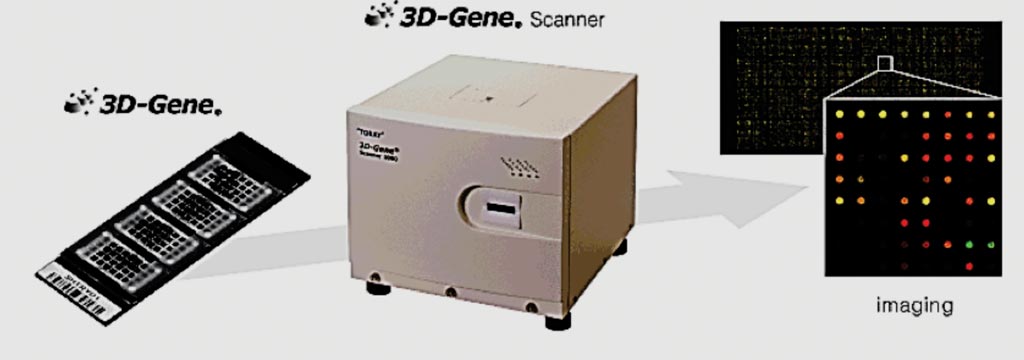
Image: The 3D Gene microarray platform (Photo courtesy of Toray Industries).
Analyzing microRNAs (miRNAs) within urine extracellular vesicles (EVs) is important for realizing miRNA-based, simple, and noninvasive early disease diagnoses and timely medical checkups.
A new approach for detecting cancer biomarkers in urine has been developed using a device composed of nanowires anchored into a microfluidic substrate. This device enables EV collections at high efficiency and in situ extractions of various miRNAs of different sequences (around 1,000 types) that significantly exceed the number of species being extracted by the conventional ultracentrifugation method.
Scientists at Nagoya University (Furo-cho, Japan) and their colleagues fabricated nanowire-anchored microfluidic device for in situ extraction of urine EV–encapsulated miRNAs was fabricated by bonding the nanowire-embedded polydimethylsiloxane (PDMS) substrate and a herringbone-structured PDMS substrate. This new approach relies on playing the forces of negatively charged EVs off of positively charged nanowires to extract the miRNAs from the urine of patients with a variety of diseases. The team looked at samples from patients with pancreatic, liver, bladder, and prostate cancer, in addition to healthy subjects.
The scientists used a syringe pump to flow urine into the device, and then transferred the extracted samples on Toray's 3D-Gene microarray platform (Tokyo, Japan) for miRNA analysis by pipetting. Using the device, they were able to detect 1,106 different types of miRNAs in a single milliliter, versus an average yield of 200 to 400 miRNAs in total obtained using conventional methods, such as centrifugation.
The mechanical stability of the anchored nanowires during the buffer flow, as well as to the electrostatic collection of EVs onto the nanowires attributed to the success of the device. The approach yielded potential cancer-related miRNAs in urine for not only urological malignancies such as prostate cancer and bladder cancer, but also non-urological ones such as liver cancer and pancreatic cancer, the scientists believe it will be widely applicable.
Takao Yasui, PhD. an assistant professor and corresponding author of the study, said, “Our developed device could allow us to collect thousands of urinary microRNAs from only 1 mL of urine. Our new approach should allow scientists to move closer to the long-term goal of urinary miRNA-based early diagnoses and timely medical checkups for a variety of cancers.” The study was published on December 15, 2017, in the journal Science Advances.
Related Links:
Nagoya University
Toray Industries
A new approach for detecting cancer biomarkers in urine has been developed using a device composed of nanowires anchored into a microfluidic substrate. This device enables EV collections at high efficiency and in situ extractions of various miRNAs of different sequences (around 1,000 types) that significantly exceed the number of species being extracted by the conventional ultracentrifugation method.
Scientists at Nagoya University (Furo-cho, Japan) and their colleagues fabricated nanowire-anchored microfluidic device for in situ extraction of urine EV–encapsulated miRNAs was fabricated by bonding the nanowire-embedded polydimethylsiloxane (PDMS) substrate and a herringbone-structured PDMS substrate. This new approach relies on playing the forces of negatively charged EVs off of positively charged nanowires to extract the miRNAs from the urine of patients with a variety of diseases. The team looked at samples from patients with pancreatic, liver, bladder, and prostate cancer, in addition to healthy subjects.
The scientists used a syringe pump to flow urine into the device, and then transferred the extracted samples on Toray's 3D-Gene microarray platform (Tokyo, Japan) for miRNA analysis by pipetting. Using the device, they were able to detect 1,106 different types of miRNAs in a single milliliter, versus an average yield of 200 to 400 miRNAs in total obtained using conventional methods, such as centrifugation.
The mechanical stability of the anchored nanowires during the buffer flow, as well as to the electrostatic collection of EVs onto the nanowires attributed to the success of the device. The approach yielded potential cancer-related miRNAs in urine for not only urological malignancies such as prostate cancer and bladder cancer, but also non-urological ones such as liver cancer and pancreatic cancer, the scientists believe it will be widely applicable.
Takao Yasui, PhD. an assistant professor and corresponding author of the study, said, “Our developed device could allow us to collect thousands of urinary microRNAs from only 1 mL of urine. Our new approach should allow scientists to move closer to the long-term goal of urinary miRNA-based early diagnoses and timely medical checkups for a variety of cancers.” The study was published on December 15, 2017, in the journal Science Advances.
Related Links:
Nagoya University
Toray Industries
Latest Technology News
- Inexpensive DNA Coated Electrode Paves Way for Disposable Diagnostics
- New Miniature Device to Transform Testing of Blood Cancer Treatments
- Biosensing Advancement to Enable Early Detection of Disease Biomarkers at POC
- New POC Biosensing Technology Improves Detection of Molecular Biomarkers
- Enhanced Lab Data Management and AI Critical to Labs of the Future, Finds Survey
- AI-Assisted Non-DNA Based Test Identifies Viral Infections in Minutes
- AI Method Predicts Overall Survival Rate of Prostate Cancer Patients
- Breath Test to Enable Early Detection of Breast Cancer
- First Ever Technology Recognizes Disease Biomarkers Directly in Menstrual Blood in Sanitary Towels
- Tiny Microlaser Sensors with Supercharged Biosensing Ability to Enable Early Disease Diagnosis
- Advanced Predictive Algorithms Identify Patients Having Undiagnosed Cancer
- Light Signature Algorithm to Enable Faster and More Precise Medical Diagnoses
- Disposable Microchip Technology Could Selectively Detect HIV in Whole Blood Samples
- Pain-On-A-Chip Microfluidic Device Determines Types of Chronic Pain from Blood Samples
- Innovative, Label-Free Ratiometric Fluorosensor Enables More Sensitive Viral RNA Detection
Channels
Clinical Chemistry
view channel
New Reference Measurement Procedure Standardizes Nucleic Acid Amplification Test Results
Nucleic acid amplification tests (NAATs) play a key role in diagnosing a wide range of infectious diseases. These tests are generally known for their high sensitivity and specificity, and they can be developed... Read more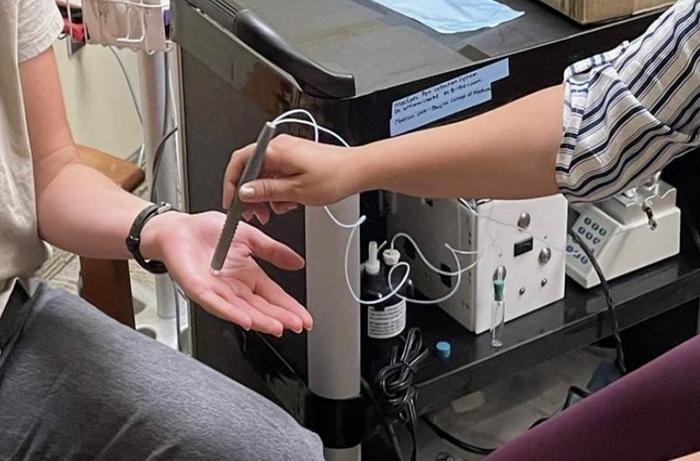
Pen-Like Tool Quickly and Non-Invasively Detects Opioids from Skin
Opioid drugs such as fentanyl, morphine, and oxycodone are the primary substances associated with overdose cases in the United States. Standard drug screening procedures typically involve collecting blood,... Read moreMolecular Diagnostics
view channel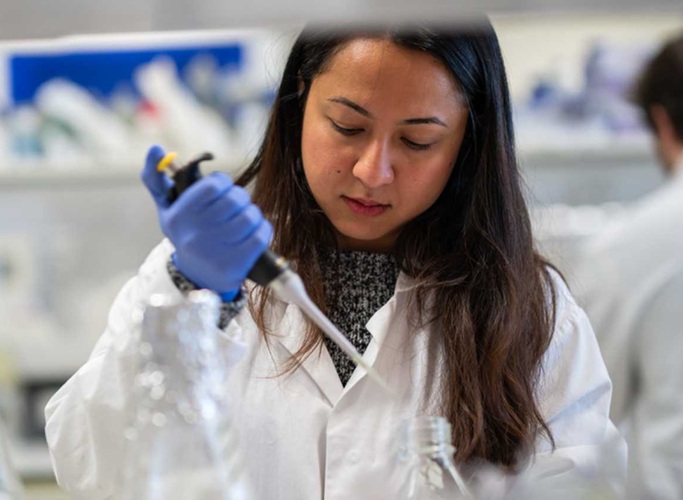
Blood Test Could Predict Likelihood of Breast Cancer Spreading to The Bone
When breast cancer spreads to other parts of the body, it becomes secondary or metastatic breast cancer—a stage that, while treatable, is currently incurable. The bone is the most common site for this... Read more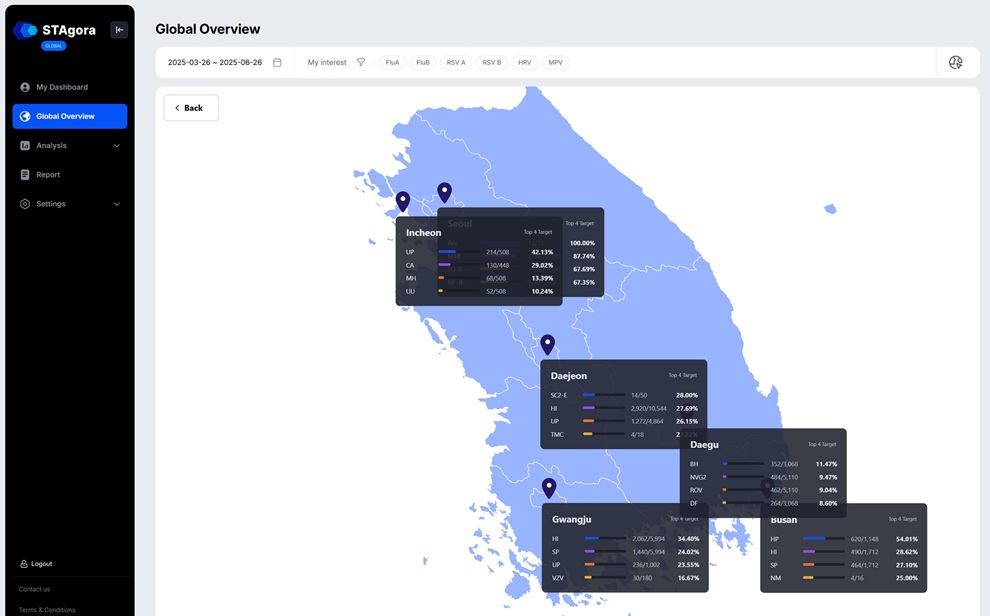
New Infectious Disease Analytics Platform Speeds Up Clinical Decision-Making at POC
During the COVID-19 pandemic, the importance of accurate and timely interpretation of diagnostic data became evident in shaping both public health strategies and clinical outcomes. As the world now grapples... Read moreHematology
view channel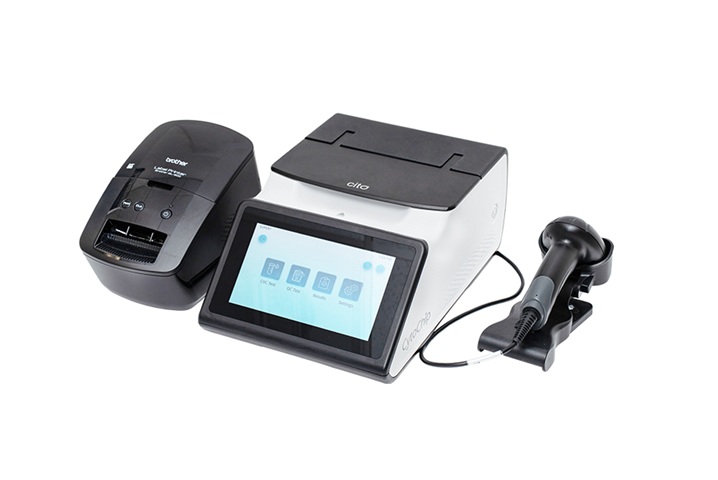
Disposable Cartridge-Based Test Delivers Rapid and Accurate CBC Results
Complete Blood Count (CBC) is one of the most commonly ordered lab tests, crucial for diagnosing diseases, monitoring therapies, and conducting routine health screenings. However, more than 90% of physician... Read more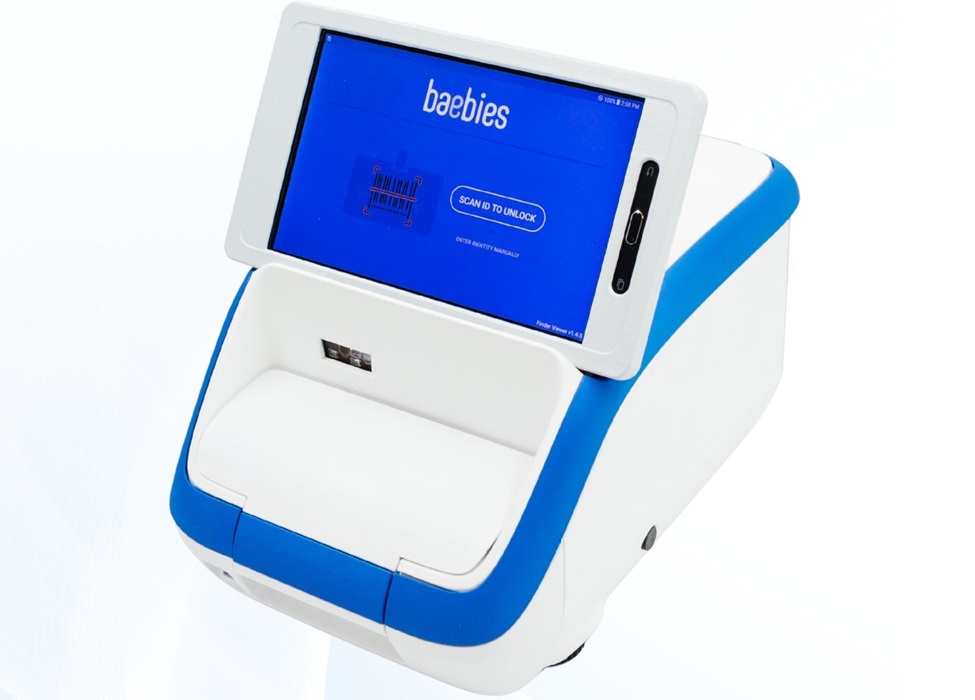
First Point-of-Care Heparin Monitoring Test Provides Results in Under 15 Minutes
Heparin dosing requires careful management to avoid both bleeding and clotting complications. In high-risk situations like extracorporeal membrane oxygenation (ECMO), mortality rates can reach about 50%,... Read moreImmunology
view channel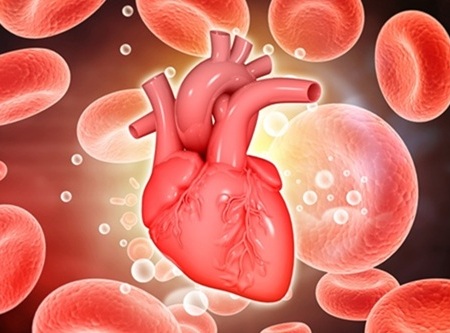
Blood Test Detects Organ Rejection in Heart Transplant Patients
Following a heart transplant, patients are required to undergo surgical biopsies so that physicians can assess the possibility of organ rejection. Rejection happens when the recipient’s immune system identifies... Read more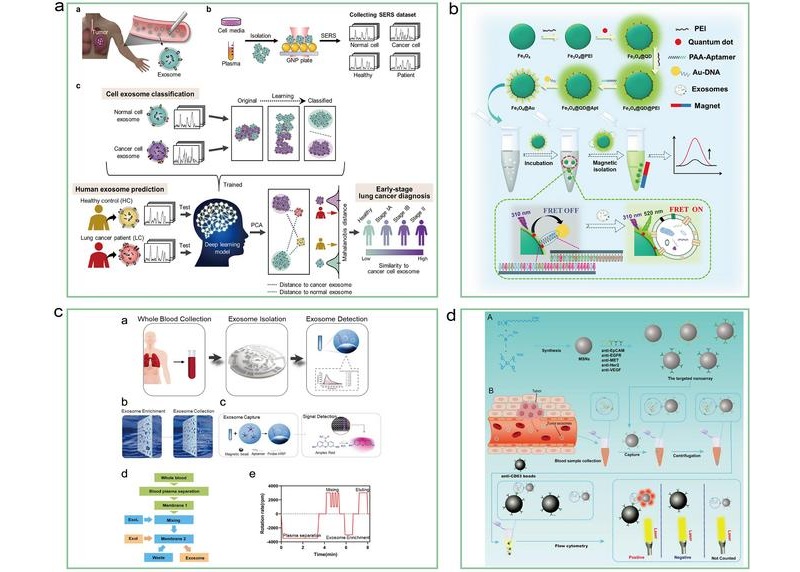
Liquid Biopsy Approach to Transform Diagnosis, Monitoring and Treatment of Lung Cancer
Lung cancer continues to be a major contributor to cancer-related deaths globally, with its biological complexity and diverse regulatory processes making diagnosis and treatment particularly difficult.... Read more
Computational Tool Exposes Hidden Cancer DNA Changes Influencing Treatment Resistance
Structural changes in tumor DNA are among the most damaging genetic alterations in cancer, yet they often go undetected, particularly when tissue samples are degraded or of low quality. These hidden genomic... Read moreMicrobiology
view channel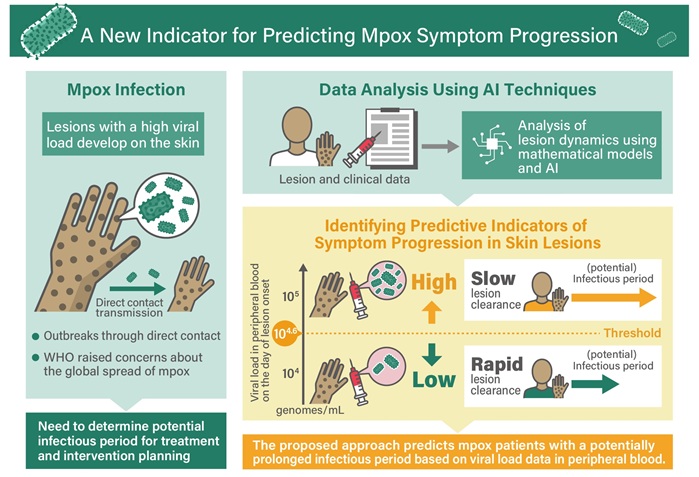
Viral Load Tests Can Help Predict Mpox Severity
Mpox is a viral infection that causes flu-like symptoms and a characteristic rash, which evolves significantly over time and varies between patients. The disease spreads mainly through direct contact with... Read more
Gut Microbiota Analysis Enables Early and Non-Invasive Detection of Gestational Diabetes
Gestational diabetes mellitus is a common metabolic disorder marked by abnormal glucose metabolism during pregnancy, typically emerging in the mid to late stages. It significantly heightens the risk of... Read morePathology
view channelAI Performs Virtual Tissue Staining at Super-Resolution
Conventional histopathology, essential for diagnosing various diseases, typically involves chemically staining tissue samples to reveal cellular structures under a microscope. This process, known as “histochemical... Read moreAI-Driven Preliminary Testing for Pancreatic Cancer Enhances Prognosis
Pancreatic cancer poses a major global health threat due to its high mortality rate, with 467,409 deaths and 510,992 new cases reported worldwide in 2022. Often referred to as the "king" of all cancers,... Read more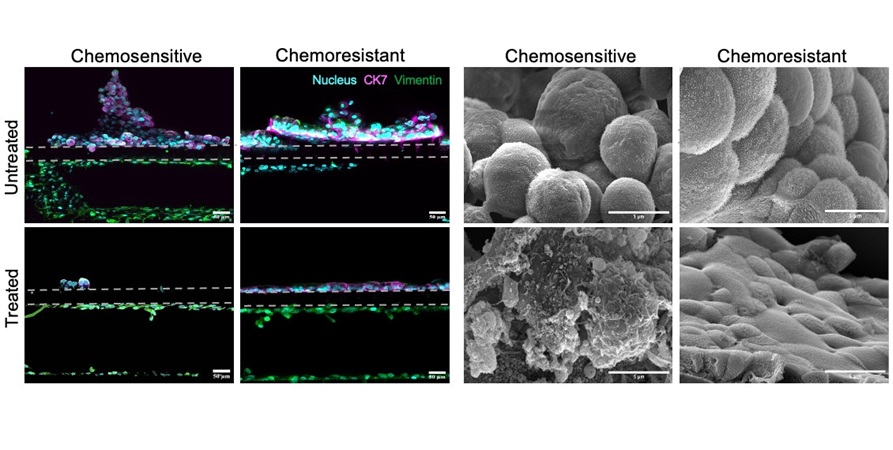
Cancer Chip Accurately Predicts Patient-Specific Chemotherapy Response
Esophageal adenocarcinoma (EAC), one of the two primary types of esophageal cancer, ranks as the sixth leading cause of cancer-related deaths worldwide and currently lacks effective targeted therapies.... Read more
Clinical AI Solution for Automatic Breast Cancer Grading Improves Diagnostic Accuracy
Labs that use traditional image analysis methods often suffer from bottlenecks and delays. By digitizing their pathology practices, labs can streamline their work, allowing them to take on larger caseloads... Read moreIndustry
view channel
AMP Releases Best Practice Recommendations to Guide Clinical Laboratories Offering HRD Testing
Homologous recombination deficiency (HRD) testing identifies tumors that are unable to effectively repair DNA damage through the homologous recombination repair pathway. This deficiency is often linked... Read more























